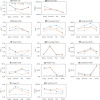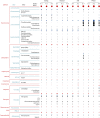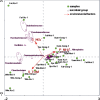Illumina sequencing-based analysis of sediment bacteria community in different trophic status freshwater lakes
- PMID: 28173613
- PMCID: PMC5552931
- DOI: 10.1002/mbo3.450
Illumina sequencing-based analysis of sediment bacteria community in different trophic status freshwater lakes
Abstract
Sediment bacterial community is the main driving force for nutrient cycling and energy transfer in aquatic ecosystem. A thorough understanding of the community's spatiotemporal variation is critical for us to understand the mechanisms of cycling and transfer. Here, we investigated the sediment bacterial community structures and their relations with environmental factors, using Lake Taihu as a model system to explore the dependence of biodiversity upon trophic level and seasonality. To combat the limitations of conventional techniques, we employed Illumina MiSeq Sequencing and LeFSe cladogram to obtain a more comprehensive view of the bacterial taxonomy and their variations of spatiotemporal distribution. The results uncovered a 1,000-fold increase in the total amount of sequences harvested and a reverse relationship between trophic level and the bacterial diversity in most seasons of a year. A total of 65 phyla, 221 classes, 436 orders, 624 families, and 864 genera were identified in the study area. Delta-proteobacteria and gamma-proteobacteria prevailed in spring/summer and winter, respectively, regardless trophic conditions; meanwhile, the two classes dominated in the eutrophication and mesotrophication lake regions, respectively, but exclusively in the Fall. For LEfSe analysis, bacterial taxon that showed the strongest seasonal or spatial variation, majority had the highest abundance in spring/summer or medium eutrophication region, respectively. Pearson's correlation analysis indicated that 5 major phyla and 18 sub-phylogenetic groups showed significant correlation with trophic status. Canonical correspondence analysis further revealed that porewater NH4+ -N as well as sediment TOM and NOx -N are likely the dominant environmental factors affecting bacterial community compositions.
Keywords: Illumina Sequencing; Lake Taihu; bacteria communities and biodiversity; sediment; trophic status of aquatic ecosystem.
© 2017 The Authors. MicrobiologyOpen published by John Wiley & Sons Ltd.
Figures








References
-
- Aizaki, M. (1981). Application of modified Carlson's trophic state index to Japanese lakes and its relationships to other parameters related to trophic state. National Institute for Environmental Studies, Japan, 23, 13–31.
-
- Bartosch, S. , Hartwig, C. , Spieck, E. , & Bock, E. (2002). Immunological detection of Nitrospira‐like bacteria in various soils. Microbial Ecology, 43, 26–33. - PubMed
-
- Bauer, M. , Kube, M. , Teeling, H. , Richter, M. , Lombardot, T. , Allers, E. , … Glockner, F. O. (2006). Whole genome analysis of the marine Bacteroidetes'Gramella forsetii’ reveals adaptations to degradation of polymeric organic matter. Environmental Microbiology, 8, 2201–2213. - PubMed
Publication types
MeSH terms
Substances
LinkOut - more resources
Full Text Sources
Other Literature Sources

